What does AI mean for the future of jobs?

It seems that artificial intelligence, or AI, has reached an inflexion point. Automation has been a key driving force affecting most industries and labour markets across the world for decades. However, the recent qualitative shift in machine learning and AI technologies may have taken us to a tipping point, analogous to the industrial revolution and the internet.
With the explosion of apps like ChatGPT that can hold ‘conversations’, write software programmes, and convert descriptions into realistic images, white collar knowledge and creative jobs may now be in the firing line after disruption in more technical fields.
We looked at what experts have to say on the subject, and the consensus seems to be that while many jobs will be lost, many new ones will be created too. For a better understanding, here we give an overview of what AI is and its current state, how different industries and skills are likely to be impacted, and what firms and workers should do to adjust.
What AI can and cannot do
In the simplest terms, AI is “the ability of a digital computer or computer-controlled robot to perform tasks commonly associated with intelligent beings.” This includes intellectual processes characteristic of humans, such as the ability to reason and apply logic, discover meaning, generalise, or learn from past experience.
According to research by the MIT Work of the Future initiative, at the moment, “Narrow AI solutions exist for a wide range of specific problems, and can do a lot to improve efficiency and productivity within the work world.” What is being described here has also been termed “specialised intelligence”, whereby AI systems work by solving problems in specific areas, often by relying on complex pattern recognition. Well known examples include IBM’s Watson, which beat humans at trivia, and Google’s AlphaGo program, which defeated human players at the game of Go. Similar narrow AI systems exist in diverse industries such as insurance and healthcare. Broadly speaking, specialised AI systems tend to be task-oriented and conduct a limited sets of tasks or functions.
This can be contrasted with “general intelligence”, which is possessed by human beings. This is the “ability to undertake a wide variety of tasks in a broad range of settings.” Although apps like ChatGPT and Midjourney show that AI is moving in that direction, by and large it remains specialised for now. Specifically, adapting and adjusting to novel and uncertain situations remains a key challenge for AI, which is something companies still rely on humans to do. Attributes such as social interaction, common sense, and dealing with unpredictable changes in the physical environment continue to be the forte of human workers.
What is going to change?
Although AI is unlikely to take over all work from humans any time soon, this does not mean that big shifts in the labour market aren’t already happening. This is because while the specialised intelligence has its limits, it has very broad applicability, and will make some types of roles redundant.
A study by the consulting form BCG, published in 2021, predicted the state of labour markets in three major world economies by 2030: the US, Germany, and Australia. It took into account the effect of various technologies, and identified certain job functions likely to have labour surpluses in 2023, indicating attrition. A finding common to all three markets was that highly repetitive roles, such as data entry and information management, are most at risk of being eliminated as new technology will increasingly be able to perform these tasks. The Future of Jobs Report 2020 issued by the World Economic Forum (WEF) offered a similar prediction, with data entry clerks, administrative secretaries, and financial clerks the three job categories likely to suffer the largest fall in demand.
On the flip side, as has happened with every major change in technology, the growth of AI will generate new types of employment and higher demand for certain functions. According to the BCG study, computer science-related jobs will by far face the largest shortfall in supply across the US, Germany, and Australia by 2030, indicating that they will see the highest rise in demand. Similarly, the WEF report lists jobs in data analysis, machine learning, digital marketing, and business development as key areas that will experience growth due to greater AI adoption. This will likely happen because core human abilities such as empathy, creativity, and emotional intelligence cannot be easily replicated by technology, and may even become more valuable in the future.
While exact predictions are difficult to make, we think the following list of top five job categories by growing and declining demand until 2025 compiled in the WEF report, is a fair assessment.
Growing demand:
- Data Analysts and Scientists
- AI and Machine Learning Specialists
- Big Data Specialists
- Digital Marketing and Strategy Specialists
- Process Automation Specialists
Declining demand:
- Data Entry Clerks
- Administrative and Executive Secretaries
- Accounting and Payroll Clerks
- Accountants and Auditors
- Assembly and Factory Workers
AI and humans, not AI or humans
With both positive and negative impacts on the labour market, what will the net effect be? Predicting the exact effects of technological change is notoriously difficult, but some broad trends can be discerned. The WEF report estimated that by 2025, about 85 million jobs are likely to be eliminated, while 97 million new ones could be created, resulting in a net positive addition.
Even in this optimistic scenario, there will be some major structural changes that policy makers, companies, and workers will have to grapple with. The WEF estimated that the core skills of up to 40% of workers in 2020 would likely change by 2025, and half of all workers would have to be re-skilled in that period. More specifically, based on the various analyses we have reviewed, the most sought after skills categories of the future will be:
- Problem solving
- Adaptability
- Social interaction
- Emotional intelligence
- Creativity
- Technology use and development
For firms, this means a huge human capital development effort in the coming years. They should start by evaluating future demand on the basis of their medium to long-term strategic direction, and determine the gaps for specific jobs and skills. Since the labour market will be unable to supply enough new talent for these, companies will need to supplement external hiring with strong internal development programmes to upskill and reskill existing workers. They should also strength their internal training programmes to keep up with the accelerating need for new skills.
The changing labour market means that workers in the future will have to be more proactive to meet their individual reskilling or upskilling needs. Lifelong learning will become a new normal, and it will be increasingly difficult to rest on the knowledge attained through schools and universities for an entire career. Whether through programs offered by employers, certifications, or other sources, the acquisition of new skills will have to become part of an individual’s professional life.
The age of AI will be incredibly disruptive, about which there is very little doubt. To navigate this transition, it is helpful to think of the future as people with computers, instead of people or computers. This provides an opportunity to thrive for flexible and curious workers, as well as organisations.









